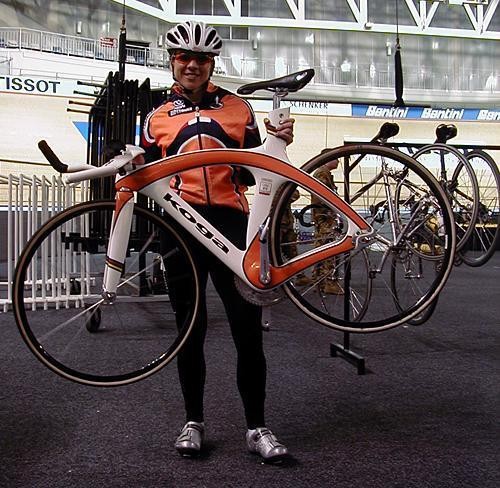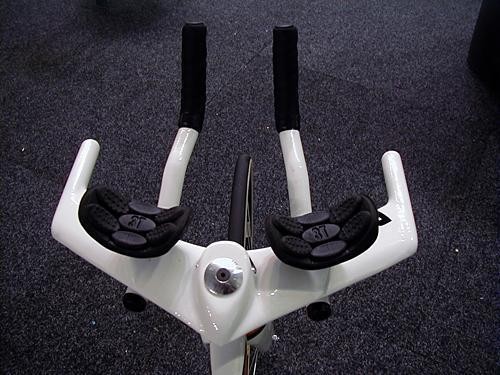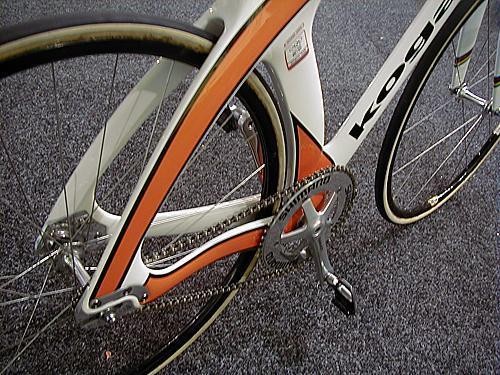Longevity rules in the Van Moorsel shed
Got tech? Send press releases, news, and tech questions to the Cyclingnews tech-heads . The bikes...



Tech feature - June 21, 2004
Got tech? Send press releases, news, and tech questions to the Cyclingnews tech-heads.
The bikes ridden by the Dutch team at the recent world track championships came not from some from Netherlands skunk works but from Bike Technologies Australia, a Melbourne firm that is currently finishing off brand new road time trial frames for Leontien Zijlaard - Van Moorsel. Gerard Knapp reports.
Professional cyclists usually churn through two or more bikes per season, so it's quite a surprise that the bike used by Leontien Zijlaard - Van Moorsel to win Olympic gold and one silver medals in 2000, as well as subsequent track world's gold medals, has only just been retired. You'd have expected the Dutch government to claim the machine as a national icon, given the achievements by the rider aboard the white and orange carbon fibre machine.
Instead, LVM took the bike home and continued to race on it for another three years and along the way, she secured more gold medals. It's still in Leontien's keeping, even if the company that made the frame would like to place it in a glass enclosure.
It's not that uncommon for track racers to hold on to their bikes for more than one season as the bikes don't really have to endure the same harsh treatment as road machines, nor are they so closely linked to road bike manufacturers' marketing programs.
As close watchers of track racing have probably noted, the Dutch team's frames - including those used by new sprint sensation Theo Bos - are made by BT (Bike Technologies), an Australian company based in Melbourne.
Get The Leadout Newsletter
The latest race content, interviews, features, reviews and expert buying guides, direct to your inbox!
BT produces monocoque carbon fibre frames that are highly distinctive. The frame's main section sweeps back from the steering head down to the track-ends (rear wheel) in one continuous arc. The down tube is straight, while the seat tube follows the arc of the rear wheel for improved aerodynamics. The combination of two arcs and the straight downtube has led to one of the most easily recognisable - and fastest - track frames in the world.
In Melbourne, LVM was riding a completely new BT frame, as were the Australian team (painted in very bright yellow). They look very similar to the previous models and perhaps it's no real surprise that the Dutch rider said, "it feels much the same".
Pushed for more details, she said, "but this one is better. It sits a bit lower."
Husband and coach/partner, Michael Zijlaard, explained that their approach to improving performance is based on improving aerodynamics. "We're not going to choose a bigger gear or longer cranks," he said. "We want to be more aerodynamic."
Cyclingnews spoke to the couple before the women's IP was held - the event where kiwi rider Sarah Ulmer broke LVM's four year-old world record. At that time, they were playing down their chances at the worlds, given it was the rider's first serious hit-out on the track for the year. The Dutch rider certainly acknowledged Ulmer's performance, but the competitive instinct was not far from the surface.
One could expect she will return to competition in Athens with not only her new bike fully sorted, but also a new 'I'm here to win' attitude. Van Moorsel expects the record will fall again in Athens.
Zijlaard said little had changed in his wife's bike set-up; she still uses 170mm cranks for the track (and 172.5mm for the road), still bases most IPs around a 52 x 15 gear and lowers the 710mm saddle height by a couple of mil's for road work. Setback (as measured from the tip of the Selle Italia saddle to the center of the bottom bracket) is 60mm for the road and slightly tighter for the track, at 50mm.
On race days, the FIR carbon fibre disc wheels get pulled out of their bags and they run on "special bearings" made by a "special mechanic" at Shimano in Holland. The other components are either BT for carbon fibre bits, and Shimano cranks and SPD-SL pedals.
The photos show the training wheels used by LVM for all her practice, as she prefers to train without the additional aero benefit of the disc wheels. The 18-spoke front and 24-spoke rear are among the special wheels made for her attempt on the 'traditional' hour record.
Her training regime at the world's in Melbourne would include sitting two metres behind the Dutch men's team pursuit squad as they cranked up to full speed - and attempting to hold that distance for as long as possible - normally three-to four laps.
BT for the road
While in Melbourne, LVM also checked on progress on her new road time trial machines that are being built by Sal Sansonetti and his crew at BT.
There are two road TT frames being: one for normal conditions, another for if it's windy on the day of the women's road ITT.
The Sansonetti crew are delighted to work with one of the world's best cyclists - the development of a road frame is an indicator to ongoing product development by the Australian company.
So how did this Dutch rider get to know about the bikes made from a specialized, small output firm on the completely opposite side of the world?
It was during a visit to Sydney in 1999 to check out the Olympics road course and velodrome. As told by Ray Godkin, the then Competition Manager (Cycling) for the Sydney Olympics Organising Committee (now vice-president of the UCI), Van Moorsel saw one of the BT bikes while she was at the track and asked if she could ride it, mainly to get a feel of the track. However, it wasn't the track so much that impressed her, it was the bike and apparently they couldn't get her off the velodrome. The only solution was to get her own frame from BT and a year later, considerable success followed.
Photos
Images by Gerard Knapp/Cyclingnews
- Leontien Zijlaard - Van Moorsel shows off her new track bike.
- Tasty carbon fibre aero ‘bar setup made by BT.
- Pictured in the infield of the Vodafone Arena, the Dutch team’s paint scheme nicely follows the sweeping lines of the BT frame.
- Pilot’s view of the new pursuit bike.
- The view from the rear with heavily reinforced track ends - and this is the lighter-weight endurance rider’s version. Cross-winds in a velodrome are not an issue so the bike can afford deep seat-stays.
- The 18-spoke front wheel is for training only and it was used by LVM for her attempt on the ‘traditional’ hour record.
- Eight BTs in a row, with a ninth further up the track, as the Australian team goes through a training session.